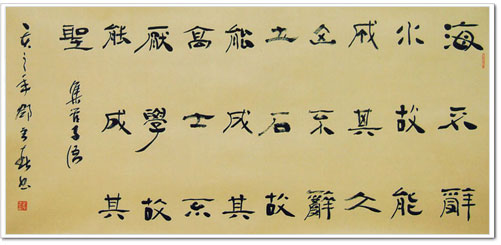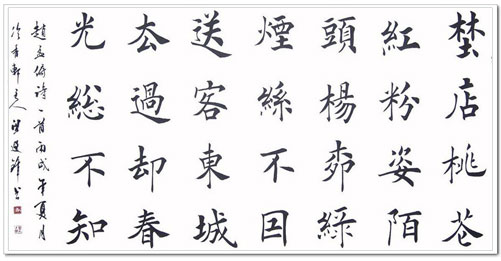 Chinese Calligraphy dates back to the earliest days of Chinese history, and is still widely practiced throughout China. Although it uses Chinese words as its vehicle of expression, one does not have to know Chinese to appreciate its beauty. Calligraphy is an abstract art. Characters inscribed on turtle shells and animal bones over three thousand years ago are the earliest systematic Chinese written language extant today. The inscriptions were mainly used for divination and keeping records of events that happened in the late Shang dynasty Most of them were found at the Shang capital city, Yin (today's Xiaomencun, Anyang, Henan).
Chinese Calligraphy dates back to the earliest days of Chinese history, and is still widely practiced throughout China. Although it uses Chinese words as its vehicle of expression, one does not have to know Chinese to appreciate its beauty. Calligraphy is an abstract art. Characters inscribed on turtle shells and animal bones over three thousand years ago are the earliest systematic Chinese written language extant today. The inscriptions were mainly used for divination and keeping records of events that happened in the late Shang dynasty Most of them were found at the Shang capital city, Yin (today's Xiaomencun, Anyang, Henan).
Bronze inscriptions appeared in the Shang dynasty (16th -11th century BC) and became fully developed in the Western Zhou dynasty
The emperor, who unified the country and founded the Qin dynasty in 221 BC standardized Chinese characters into a form called simplified seal script. It emphasized the regularity and symmetry of each character. The official script was adopted into Chinese writing in the late Warring States period (3rd century BC) and came into vogue in the Eastern Han dynasty (25-220). It changed the round linear style of Chinese characters into square lines, thus initiating a new style of Chinese writing. The execution of heavy-down and light-up brushstrokes laid a good foundation for the later emergence of the regular script.
 In the Western Han dynasty, a simpler form of the official script was developed by linking together the lines of a character facilitating quicker writing, which is known as "Zhang's Cursive", the earliest form of cursive script. Later, it further broke free from the conventions of the Official script and brought into being the cursive script with a distinctive aesthetic charm with links between lines as well as characters.
In the Western Han dynasty, a simpler form of the official script was developed by linking together the lines of a character facilitating quicker writing, which is known as "Zhang's Cursive", the earliest form of cursive script. Later, it further broke free from the conventions of the Official script and brought into being the cursive script with a distinctive aesthetic charm with links between lines as well as characters.
The regular script which featured a strictly regular and rigorous style attained its perfection in the Tang dynasty (618-907). A group of well-known calligraphers like Ouyang Xun, Yu Shinan, Zhu Suiliang and Xue Ji emerged in the early Tang period, and Yan Zhenqing and Liu Gongquan in the late Tang period. Among them, Yan Zhenqing's vigorous and dignified style  represents the spirit of the Tang culture.
represents the spirit of the Tang culture.
Su Shi, Wang Tingjian, Mi Fei and Cai Xiang are regarded as the four great calligraphers of the Song dynasty (960-1279)They all excelled in the running script using their own individual styles.
Some creative calligraphers of the late Ming and early Qing period boldly expressed their own artistic feelings and thoughts in their calligraphy work. The representative ones are Zhang Ruitu, Ni Yuanlu, Huang Daozhou, Wang Duo and Fu Shan.

